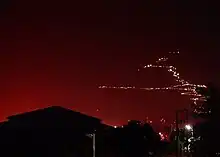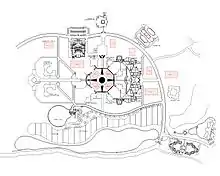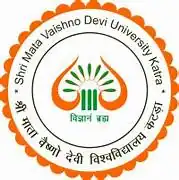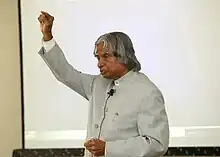Hindi: Shri Mata Vaishno Devi Vishwavidyalaya | |
 Official Logo of SMVDU | |
| Motto | "विज्ञानं ब्रह्म" meaning "God is Science" |
|---|---|
| Type | Public University |
| Established | May 12, 1999[1] |
| Accreditation | National Assessment and Accreditation Council |
Academic affiliations | UGC, AICTE, Council of Architecture,NIRF,AIU |
| Chancellor | Shri. Manoj Sinha, Lieutenant Governor of Jammu and Kashmir |
| Vice-Chancellor | Prof. Pragati Kumar[2] |
| Students | 5500+ |
| Address | SMVDU Campus, Sub Post Office, Kakryal , , , 182320 , India |
| Campus | Urban, More than 470 acres (190 ha) |
| Website | www |
Shri Mata Vaishno Devi University, (श्री माता वैष्णो देवी विश्वविद्यालय), commonly referred to as SMVD University or SMVDU, is a Government Owned Higher Institution/University located in Katra, Reasi district, Jammu and Kashmir, India. It was founded in 1999, as fully residential and technical university, a Public University recognized by UGC[3] under section 2(f) and 12(B)[4] and is established on more than an 470-acre (190 ha) residential and provides technical education in the field of engineering, architecture, science, management, philosophy and other subjects, with all technical courses recognised by AICTE, University Grants Commission (India), National Board of Accreditation and Council of Architecture.
Shri Mata Vaishno Devi University was ranked in the 100–150 category by the National Institutional Ranking Framework (NIRF) university ranking in 2020. The College of Engineering was ranked 78 by the NIRF engineering ranking in 2020. SMVDU is ranked 80th globally and 3rd within India in the Times Higher Education Impact Ranking 2021 under the UNSDG category 07.[5] SMVDU is also ranked in the 6th-25th Rank band in the government aided institutions category in the Atal Ranking of Institutions on Innovation achievements ARIIA 2020 Ranking of government of India.[6][7] TIMES HIGHER EDUCATION in their World University Rankings 2024 Ranked SMVDU in the band of 800-1000 in the World and 25th in Best Universities in India. SMVDU is one of those prominent institutes in the world whose Scientists are in the Stanford University's List of 2% & 5% Scientist in the World.
Located at a distance of 45 km (28 mi) from Jammu Airport and 14 km (8.7 mi) short of the town of Katra, the university is situated on a plateau surrounded by mountains on three sides in the foothills of the Trikuta Range where the shrine of Mata Vaishno Devi is located. It is a self-contained township with most facilities available in-house.
History



In 1998, the people of Jammu region supported the establishment of Shri Mata Vaishno Devi University. This turned into a movement which lasted for around two months. Various students, traders, lawyers and various communities joined this movement. A 17-day-long strike was observed for the cause. Ultimately, Shri Mata Vaishno Devi University (SMVDU) was established under the Jammu and Kashmir Shri Mata Vaishno Devi University Act, 1999, as an autonomous, highly technical and fully residential university.[8][9][10] The Shri Mata Vaishno Devi Shrine Board owned and funded the construction of the university. The site, spread over an area of 470 acres, was procured from Kakryal village, a flat hill across Jhajjar stream from National Highway 1A (now NH44).This University is owned by Government.


N. K. Bansal served as the Vice-Chancellor after the establishment of the university in 2004 and served until 2009. He started various programs in the disciplines of science, management, renewable energy and humanities and social science.
Campus
The university is in the proximity of the Trikuta foothills. The 1,070-acre (4.3 km2) university campus is divided into various blocks such as the Academic Block, Administrative Block, Central Library, Hostels & Residential Area. The various schools of study consist of well equipped, lecture and seminar halls, conference rooms, departmental lab and computer lab and all modern facilities.This University has one of the largest campuses in India.
The initial campus plan was designed by S.Ghosh & Associates. They won the project through a national competition. The basic plan was implemented and completed by 2006.[11]

Organization and administration
Funding
The university receives funding from Shri Mata Vaishno Devi Shrine Board, an autonomous board set up in August 1986 under the provisions of The Jammu and Kashmir Shri Mata Vaishno Devi Shrine Act, 1986 of J&K State Legislature. The university also gets funds from Government of India, Govt. of Jammu and Kashmir, UGC (University Grants Commission).
Governance
The Lieutenant Governor of Jammu and Kashmir is the Chancellor of the university and the Chairman of the Shri Mata Vaishno Devi Shrine Board.
The Executive Council of the university, with the Vice-Chancellor as its head, is the supreme body of the university. The Academic Council is the highest academic body and makes recommendations to the Executive Council on academic matters. The university also has a Finance Committee and a Building & Works Committee. The Planning Board helps the Vice-Chancellor in foreseeing the growth of the university.
Faculties
There are four colleges or faculties, with a Dean heading each one of them. Each college consists of Schools of Study, analogous to departments in a university, headed by a Director. Academic de-centralization allows each school to function in an autonomous manner.

The Schools offer various programs of study at undergraduate, post-graduate and doctorate levels.

The university has adopted an IIT/UGC pattern of study with choice-based credit system and continuous evaluation based on Grade Point Average (GPA) on a 10-point scale.[12]


Faculty of Engineering[13]
- School of Architecture and Landscape Design
- School of Computer Science Engineering
- School of Mechanical Engineering
- School of Electronics and Communication Engineering
- School of Electrical Engineering
- School of Civil Engineering
- School of Energy Management

Faculty of Management[14]
The College of Management consists of the following schools:
- School of Business
- School of Economics
Faculty of Sciences[15]
The College of Sciences consists of the following schools:
- School of Mathematics
- School of Physics
- School of Biotechnology
Faculty of Humanities & Social Science[16]
The Faculty of Humanities & Social Sciences consists of the following Departments:
- Department of Philosophy & Culture
- Department of Languages & Literature
Academics
Recognition
The university is approved by UGC under Section 2(F) & Section 12(B) of UGC Act of 1956.
The technical programs of the university are recognized by All India Council for Technical Education, while the architecture program is recognized by Council of Architecture.
University Grants Commission recognizes it under section 2(f). The first convocation was held in 2008, and delivered by Prime Minister Manmohan Singh. In 2009, UGC granted 12(b) status to the university and began issuing grants to it. University is also accredited by NAAC.
Admissions
Many students are admitted into the BTech/BArch programme every year from amongst the high rankers of JEE (Main) through the Central Seat Allocation Board (MHRD), admission from CUET is also considered. Candidates admitted to the M.B.A. programme pass through a three tier selection process based on CAT/MAT Score, group discussions and interviews conducted by panel of academicians from IITs & corporate professionals. Admissions to other post-graduate programmes (MSc, Five Years Integrated MSc Economics, MTech, MCA, M. A.)[17] are made through national entrance tests and interviews.
Academic programmes
The university follows a credit-based programme structure, which requires students to earn a sufficient number of credits in order to earn a degree. Industrial/Corporate Training is also a mandatory part of the curriculum. Students are encouraged to work on industry sponsored projects. A continuous evaluation system is followed, and evaluation techniques such as quizzes, assignments, and minor and major tests are used periodically. Each school has a Board of Studies consisting of eminent academicians and professionals from industry who update the syllabi to ensure relevance of the content vis-à-vis the needs of industry as well as research.
Extensive usage of varied contemporary pedagogy, such as multi-media teaching aids like digital projectors, OHP, net-enabled labs, video conferencing, cut-section models, and simulation software, are used to enrich the teaching–learning process. Field visits are conducted regularly to familiarise students with real world applications of the knowledge learnt.
Visiting lectures by a variety of faculty members and professionals are arranged on a regular basis to broaden the scope of learning. The university has a high student teacher ratio of 12:1.
Rankings
| University and college rankings | |
|---|---|
| General – India | |
| NIRF (Universities) (2023)[18] | 151-200 |
| Engineering – India | |
| NIRF (2023)[19] | 101-150 |
| Architecture – India | |
| NIRF (2023)[20] | 26 |
Shri Mata Vaishno Devi University was ranked in the 100-150 category by the National Institutional Ranking Framework (NIRF) university ranking in 2020. The College of Engineering was ranked 78 by the NIRF engineering ranking in 2020. The School of Architecture was ranked in the 76-100 category by the NIRF university ranking in 2020.
Student Assistantship Program
The top ten percent of students in each class are awarded scholarships, with tuition fee waivers ranging from 100% to 50% (subject to fulfillment of merit restrictions).
Outreach
The university has entered into collaboration with high-profile institutions in India and abroad, including IIT Delhi, Panjab University, Baba Saheb Bhimrao Ambedkar University, Lucknow IIIM, Kurukshetra University, Thapar University, Aachen University and Kun-Shan University.. The university has recently started hosting the British Council Higher Education Center for convenience of students. The university is among the few institutions in the country which host the Counseling Center of AIEEE-CCB.
Research
Labs and Library
The university has over 35 laboratories. In addition to the University Central Library, which contains more than 50,000 books, each school has its own reference library. A virtual digital library facility is also available and it is opening for all students. The university has further access to academic journals through the AICTE-INDEST consortium.
Research Centres
UGC has funded the following research centres established by the university to pursue active research resulting in patents, products and publications:
- Center for Embedded Instrumentation & Networked Controls
- Center of Excellence in Biotechnology
- Center for Advanced Manufacturing
- Center for Energy Management & Water Resource
- Center of Excellence for Entrepreneurial Development
Student life
Student hostels
The university has a residential system which can accommodate all the students on campus in six hostels (Vidhyanchal, Nilgiri, Trikuta, Kailash, Old & New Basohli for Boys, and Old & New Shivalik and Vaishnavi for Girls).
College festivals
Following are the major festivals in the annual calendar:
- Titiksha, the annual national level technical festival
- Tatva, a management festival
- Srijan, an architecture festival
- Resurgence, an annual cultural festival
- Sarang, a sports festival
- Lit-Life, an annual literature festival held by the Department of Languages and Literature
- Artha, an economics festival
International conferences, Annual Science Day, Annual Engineers Day, monthly "Mind-meet" panel discussions, and open source technology meetups are held regularly.
In March 2010, the university hosted[21] the Zonal NASA Convention with 750 students of architecture from North Indian architecture institutions.
See also
References
- ↑ "Facts and History". Shri Mata Vaishno Devi University. Retrieved 31 May 2021.
- ↑ "Prof Pragati Kumar appointed VC SMVDU; Dr Tripathi VC SKUAST-Jammu". Greater Kashmir. Retrieved 20 June 2023.
- ↑ "University". www.ugc.ac.in. Retrieved 22 June 2021.
- ↑ "Facts and History". www.smvdu.ac.in/index.php/about-us/facts-and-history.
- ↑ "THEimpact2021".
- ↑ "ARIIA | Atal Ranking of Institutions on Innovation Achievements". www.ariia.gov.in. Retrieved 22 June 2021.
- ↑ "ariia2020ranking" (PDF).
- ↑ "Mata Vaishno Devi University or university of "sexual" harassment – Early Times Newspaper Jammu Kashmir". Earlytimes.in. 16 May 2011. Retrieved 20 May 2012.
- ↑ PTI (8 February 2014). "Universities with innovative spirit can take J-K to new heights: Omar Abdullah". Articles.economictimes.indiatimes.com. Retrieved 23 December 2015.
- ↑ "President Addresses Third Convocation @SMVDU : Shri Mata Vaishno Devi University". Smvdu.net.in. 28 November 2011. Retrieved 23 December 2015.
- ↑ "S.Ghoah associates The buildings designed by S.Ghosh". Sghosh.com. Retrieved 20 May 2012.
- ↑ "Academic Structure of Shri Mata Vaishno Devi University". Shri Mata Vaishno Devi University. Retrieved 4 November 2010.
- ↑ "FOE".
- ↑ "FOM".
- ↑ "FOS".
- ↑ "FOHSS".
- ↑ Archived 8 October 2010 at the Wayback Machine
- ↑ "National Institutional Ranking Framework 2023 (Universities)". National Institutional Ranking Framework. Ministry of Education. 5 June 2023.
- ↑ "National Institutional Ranking Framework 2023 (Engineering)". National Institutional Ranking Framework. Ministry of Education. 5 June 2023.
- ↑ "National Institutional Ranking Framework 2023 (Architecture)". National Institutional Ranking Framework. Ministry of Education. 5 June 2023.
- ↑ "Daily Excelsior.........State". dailyexcelsior.com. Retrieved 3 November 2019.